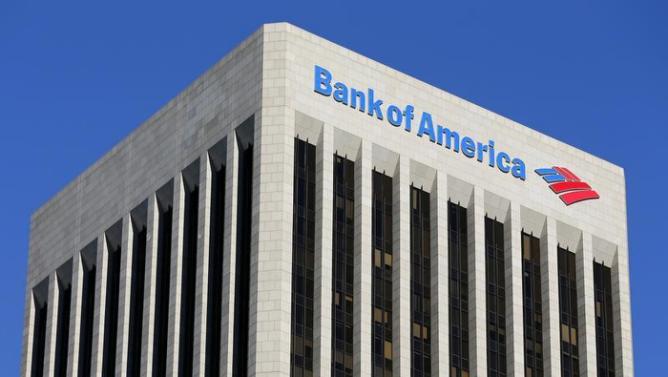Bank of America Is Poised for a Huge Profit Surge

Bank of America still isn’t the profit colossus that CEO Brian Moynihan promised when he took over the bank in 2010. But that doesn’t mean he’s not having success.
Take the fourth quarter. On Friday morning, B of A reported that sales fell slightly short of expectations, but that its earnings outpaced what analysts had been looking for. The bank’s per-share profits in the last three months of the year were 40 cents, 2 cents better than the consensus estimates. Wall Street applauded, sending shares B of A (bac) higher to $ 23.24 by midday.
The Big Number: For all of 2016, B of A recorded a 15% increase in earnings-per-share, an extremely strong result. The biggest drivers were a sharp, 5% reduction in total costs to $ 55 billion, and a drop in provisions for bad loans. B of A wrote off just 0.39% of its portfolio in 2016, versus 0.52% Q4 of 2015, a remarkable improvement that confirms Moynihan relentless focus on managing risk is working.
B of A is substantially shrank its share count via buybacks, and just announced that it will accelerate its stock repurchases of shares in the first six months of 2017 from a previously planned $ 1.8 billion to $ 4.3 billion.
According to Moynihan, it’s B of A’s huge base of extremely low-cost deposits, and its ability to keep those balances growing, that gives the franchise so much potential for big profitability. Warren Buffett, who became a major B of A investor when the bank was still trying to pull itself out of the financial crisis in 2011, agrees. And B of A’s deposit profile continues to thrive. In 2016, its balances available for lending grew by $ 64 billion or 5.3% to $ 1.261 trillion, with $ 28 billion arriving in the fourth quarter alone.
What’s Still Missing: The problem is still the “Big G,” i.e. growth. In 2016, B of A’s revenues waxed a mere 1%, barely matching inflation. Moynihan argues that B of A pursues a “responsible growth strategy” of “deepening relationships” with existing retail banking and commercial customers, as opposed to lowering its credit standards by raiding competitors.
That super-cautious approach, however, has a downside. While B of A’s deposits increased $ 64 billion in 2016, it’s total loan portfolio expanded by just $ 10 billion, or just 1.1%. Overall, B of A’s deposits far exceed its loans, and it’s parking the those excess balances in low-yielding treasuries and mortgage-backed securities, investments that produce far lower returns than the same money put to work in consumer and business loans. That mostly explains its flat revenues. Its loan book has been growing so slowly that its net interest income—the spread between its cost of deposits and the interest it charges on loans—actually declined throughout 2016, even as interest rates—what the bank can charge on loans—rose.
What’s Promising: For years, B of A has been fighting two headwinds: Extremely low interest rates, and a sluggish economy that, in Moynihan’s view, made new lending extremely difficult without shouldering the excessive risk. Keep in mind that reckless risk-taking almost sank B of A in the financial crisis. (Moynihan certainly does.)
But on the fourth quarter conference call, Moynihan cited signs of a major reversal in both factors. The generally restrained, laconic Moynihan spoke glowingly of an rise in both consumer and business optimism. “Optimism for positive change is palpable,” he said on the conference call.
“It began through the summer and into the fall. We’re seeing greater business confidence. I’m optimistic policies will be supportive of growth. The optimism is translating into loan balances.”
So it’s likely that B of A’s lending will rise at a far faster rate in 2017. In addition, CFO Paul Donofrio stated that the Fed’s recent rate increase, and a 0.75 percentage point rise in long-term rates since the end of September, should increase revenue from lending by $ 600 million in the first quarter of 2017, and that the number, quarter by quarter, should grow from there.
At the same time, Moynihan is pledging to keep hammering expenses even as B of A finally starts really growing. His target for late 2018: $ 53 billion, or $ 2 billion less than what B of A spent in 2016, on what should be a far bigger revenue base.
The Big Takeaway: If the combination of bigger revenues from higher rates, a growing loan portfolio, and declining expenses works, Moynihan will finally deliver the profit colossus—earning in the range of the roughly $ 25 billion a year that J.P. Morgan Chase brings in—that he promised more than half a decade ago.
Investors are already impressed. B of A’s stock has surged 43% since early November, adding $ 70 billion in market cap and easily outpacing Wells Fargo and J.P. Morgan. Moynihan’s view is that a bank with over $ 1.1 trillion in sticky, low-cost deposits, mainly in interest-free checking, should be a money machine as long as it doesn’t periodically give all the money back by taking reckless risks. That, though, has been the history of many of America’s big banks, very much including B of A.
Moynihan, it’s clear, gets that. We’re now seeing that his long-questioned vision was probably the right one from the start.

